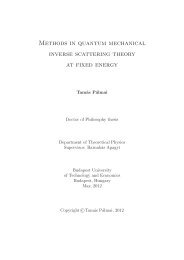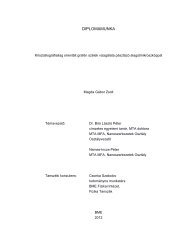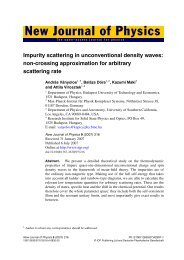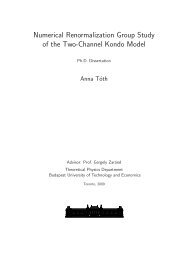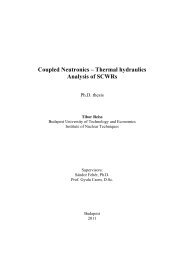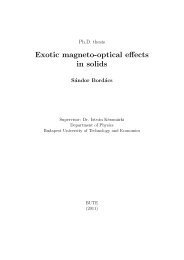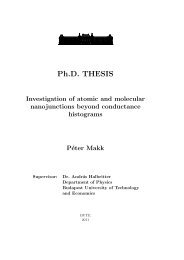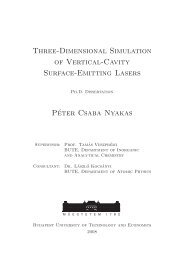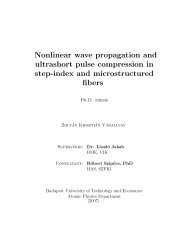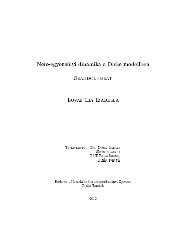Ph.D. THESIS Multipolar ordering in f-electron systems
Ph.D. THESIS Multipolar ordering in f-electron systems
Ph.D. THESIS Multipolar ordering in f-electron systems
You also want an ePaper? Increase the reach of your titles
YUMPU automatically turns print PDFs into web optimized ePapers that Google loves.
Chapter 2 Overview of the Theoretical Background 25<br />
nature of phase transitions when an external field is applied to the system.<br />
Apply<strong>in</strong>g a magnetic field <strong>in</strong> a specific direction, the symmetry of the system<br />
will be lowered. The effects are twofold. First, it may happen that the<br />
orig<strong>in</strong>al order parameter is <strong>in</strong>duced by the field; <strong>in</strong> this case, the concept of a<br />
spontaneous symmetry break<strong>in</strong>g transition is no longer applicable. Second,<br />
even if the order parameter is not <strong>in</strong>duced by the field, and therefore a<br />
cont<strong>in</strong>uous phase transition rema<strong>in</strong>s possible, it will be generally true that<br />
more order parameters are coupled than <strong>in</strong> the absence of the field. In any<br />
case, a magnetic field can couple g and u order parameters. We return to a<br />
detailed discussion of these po<strong>in</strong>ts <strong>in</strong> Chapter 3.<br />
2.6 Review of f-<strong>electron</strong> Systems<br />
f-<strong>electron</strong> <strong>systems</strong> are the rare earth and act<strong>in</strong>ide elements, their compounds,<br />
and alloys. In all cases, the spectrum of the strongly correlated f-<strong>electron</strong>s<br />
overlaps with wide s-, p-, and d-bands. The overlap (hybridization) may,<br />
or it may not, lead to the formation of f-bands (or <strong>in</strong> other words, the<br />
participation of f-<strong>electron</strong>s <strong>in</strong> form<strong>in</strong>g a Fermi sea). Even if the f-<strong>electron</strong>s<br />
do become it<strong>in</strong>erant, they tend to form very narrow, strongly correlated heavy<br />
fermion bands. The formation of a heavy Fermi sea is driven by k<strong>in</strong>etic<br />
energy, and is a low-energy phenomenon. Intermediate-energy excitations<br />
are essentially propagat<strong>in</strong>g crystal field excitations. However, <strong>in</strong> most f-<br />
<strong>electron</strong> <strong>systems</strong>, the f-<strong>electron</strong>s can be thought of as hav<strong>in</strong>g undergone a<br />
Mott localization of their own, even if they are surrounded by a conduct<strong>in</strong>g<br />
Fermi sea of wide-band <strong>electron</strong>s.<br />
I treat f-<strong>electron</strong>s as completely localized. This is certa<strong>in</strong>ly right for the<br />
0.4eV-gap semiconductor NpO 2 . However, the assumption about the localized<br />
multipolar degrees of freedom has a certa<strong>in</strong> justification even for <strong>systems</strong><br />
where f-<strong>electron</strong>s have it<strong>in</strong>erant, as well as localized, aspects. It is known<br />
that <strong>in</strong>ter-site <strong>in</strong>teractions prefer f-<strong>electron</strong> localization, and therefore a system<br />
may have two compet<strong>in</strong>g phases: the non-ordered heavy Fermi sea, and<br />
the <strong>in</strong>teract<strong>in</strong>g array of localized f-<strong>electron</strong>s. Therefore, whenever we see a<br />
transition to a phase with multipolar order, we may assume that it is accompanied<br />
by f-<strong>electron</strong> localization. We cite the experimental f<strong>in</strong>d<strong>in</strong>g for<br />
PrFe 4 P 12 : the disordered phase is a heavy fermion metal with broad excitations,<br />
while the crystal field levels become sharply def<strong>in</strong>ed when multipolar<br />
order sets <strong>in</strong>.<br />
Many f-<strong>electron</strong> <strong>systems</strong> order magnetically. However, quite a few f-<br />
<strong>electron</strong> <strong>systems</strong> have phase transitions which are thermodynamically as<br />
strong as the magnetic transitions, but the low temperature phase is not



